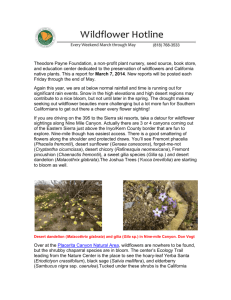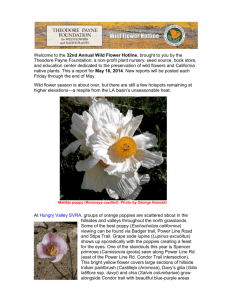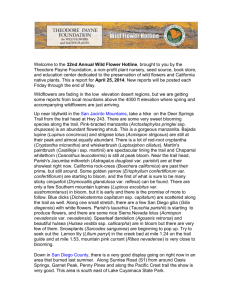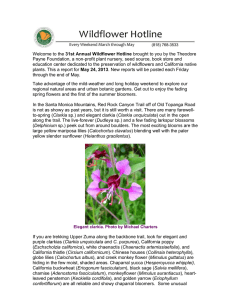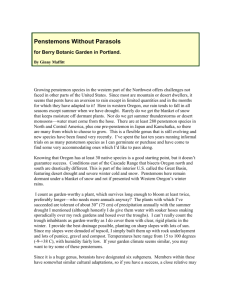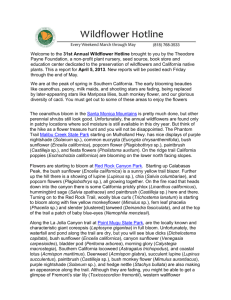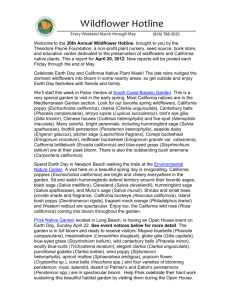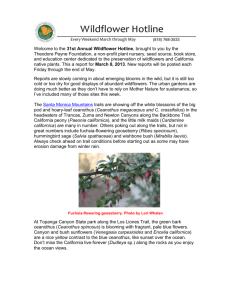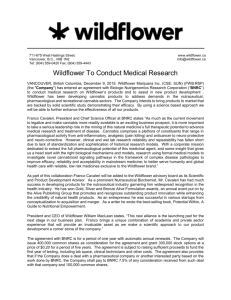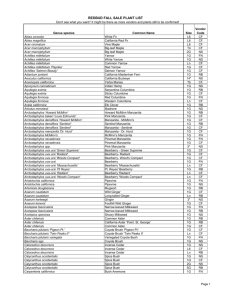doc May 3 - Theodore Payne Foundation
advertisement
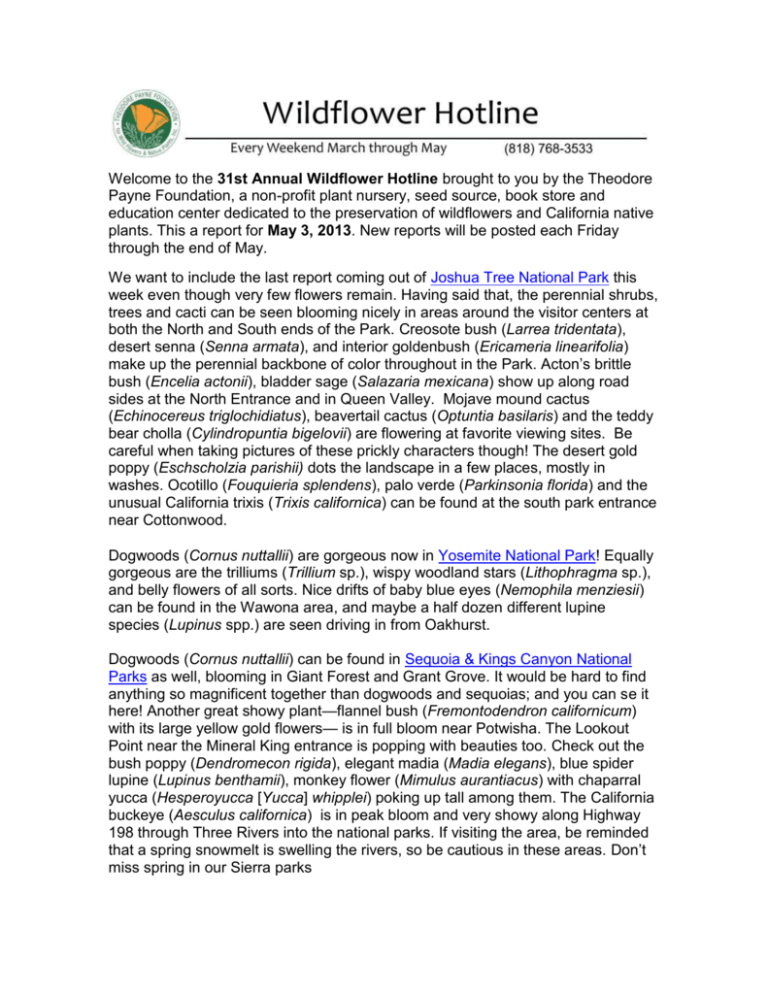
Welcome to the 31st Annual Wildflower Hotline brought to you by the Theodore Payne Foundation, a non-profit plant nursery, seed source, book store and education center dedicated to the preservation of wildflowers and California native plants. This a report for May 3, 2013. New reports will be posted each Friday through the end of May. We want to include the last report coming out of Joshua Tree National Park this week even though very few flowers remain. Having said that, the perennial shrubs, trees and cacti can be seen blooming nicely in areas around the visitor centers at both the North and South ends of the Park. Creosote bush (Larrea tridentata), desert senna (Senna armata), and interior goldenbush (Ericameria linearifolia) make up the perennial backbone of color throughout in the Park. Acton’s brittle bush (Encelia actonii), bladder sage (Salazaria mexicana) show up along road sides at the North Entrance and in Queen Valley. Mojave mound cactus (Echinocereus triglochidiatus), beavertail cactus (Optuntia basilaris) and the teddy bear cholla (Cylindropuntia bigelovii) are flowering at favorite viewing sites. Be careful when taking pictures of these prickly characters though! The desert gold poppy (Eschscholzia parishii) dots the landscape in a few places, mostly in washes. Ocotillo (Fouquieria splendens), palo verde (Parkinsonia florida) and the unusual California trixis (Trixis californica) can be found at the south park entrance near Cottonwood. Dogwoods (Cornus nuttallii) are gorgeous now in Yosemite National Park! Equally gorgeous are the trilliums (Trillium sp.), wispy woodland stars (Lithophragma sp.), and belly flowers of all sorts. Nice drifts of baby blue eyes (Nemophila menziesii) can be found in the Wawona area, and maybe a half dozen different lupine species (Lupinus spp.) are seen driving in from Oakhurst. Dogwoods (Cornus nuttallii) can be found in Sequoia & Kings Canyon National Parks as well, blooming in Giant Forest and Grant Grove. It would be hard to find anything so magnificent together than dogwoods and sequoias; and you can se it here! Another great showy plant—flannel bush (Fremontodendron californicum) with its large yellow gold flowers— is in full bloom near Potwisha. The Lookout Point near the Mineral King entrance is popping with beauties too. Check out the bush poppy (Dendromecon rigida), elegant madia (Madia elegans), blue spider lupine (Lupinus benthamii), monkey flower (Mimulus aurantiacus) with chaparral yucca (Hesperoyucca [Yucca] whipplei) poking up tall among them. The California buckeye (Aesculus californica) is in peak bloom and very showy along Highway 198 through Three Rivers into the national parks. If visiting the area, be reminded that a spring snowmelt is swelling the rivers, so be cautious in these areas. Don’t miss spring in our Sierra parks Dogwood (Cornus nuttallii) at Yosemite. Photo by John Wickman At Hungry Valley SRVA near Gorman, California poppies (Eschscholzia californica) are blooming in bright orange and gold drifts. Heading south from the North Entrance kiosk along Wheatfield/Powerline/Saltlick trails loop, the poppies greet and wave at you along the roadsides. Powerline Road is especially nice with poppies, lupines (Lupinus sp.) and the balsam root sunflower (Balsamorhiza deltoidea). Chaparral yucca (Hesperoyucca whipplei) is stunning with its tall spikes of large creamy white flowers now in bloom all over the park. Look out too, (well you really can’t miss them!) for the bright red scarlet buglers ((Penstemon centranthifolius). Balsam root sunflower (Balsamorhiza deltoidea) and scarlet bugler (Penstemon centranthifolius). Hungry Valley SRVA. Photo by Lora Owens Find an amazing view at Descanso Gardens, where the Matilija poppies (Romneya coulteri) are framed by the distant San Gabriel Mountains. Throughout the Native Garden you will see the elderberry (Sambucus nigra) with its sprays of creamy white flowers, foothill penstemon (Penstemon heterophyllus), and California wild rose (Rosa californica). Throughout the garden, showy penstemon (Penstemon spectabilis) and Douglas’s iris (Iris douglasiana) are putting on nice displays. The Native Garden Wildflower Patch is displaying bird’s eye gilia (Gilia tricolor), tidy tips (Layia platyglossa), five spot (Nemophila maculata) and chia (Salvia columbariae). The various perennial sages both species and cultivars (Salvia spp.) are in bloom all over the Descanso paradise. Zoo Drive at the easternmost end of the Santa Monica Mountains and Griffith Park, has a colorful show of bush sunflower (Encelia californica) and Matillija poppies (Romneya coulteri). Look up at the chaparral covered slopes of Griffith Park for bush monkeyflower (Mimulus aurantiacus) and evening primrose (Oenothera sp.). This colorful scene of native flowers nicely frames the Zoo’s wild critters. It’s the bight pink prickly phlox (Linanthus [Leptodactylon] californicus) popping all over Stough Canyon Nature Center in the Verdugo Mountains and competing for your attention with the showy orange and yellow monkey flower (Mimulus aurantiacus). The succulent lupines (Lupinus succulentus) are fading, but are being replaced by the elegant clarkia (Clarkia unguiculata)—a very nice late spring transition of color from blue to pink. Caterpillar phacelia (Phacelia cicutaria) is crawling all over the hillsides in Stough Canyon while bush sunflower (Encelia californica) and California wild rose (Rosa californica) are decorating the Nature Center garden. The trails at Eaton Canyon have abundant white sage (Salvia apiana) in bloom. It is quite pretty to see so much of it. The demonstration garden at the Nature Center building is going strong with plenty of diversity of flowering natives. Displays include pitcher sage (Lepechinia fragrans), showy penstemon (Penstemon spectabilis), monkeyflower (Mimulus aurantiacus), poppies (Eschscholzia californica), golden yarrow (Eriophyllum confertiflorum), cleveland sage (Salvia clevelandii) creek monkeyflower (Mimulus guttatus) and scarlet monkey flower (Mimulus cardinalis). Farnsworth Jewelflower & San Clemente Island Brodiaea at ELC Photos by George Nanoski The perennials are the second act to the opening show of the annual wildflowers at Elizabeth Learning Center in Cudahy. The Matillija poppies (Romneya coulteri) are like beaming headlights. The central habitat garden is host to many of California’s rare plant species. The San Clemente Island brodiaea (Brodiaea kinkienis), the Santa Rosa Island white felted paintbrush (Castilleja lanata ssp. hololeuca), Farnsworth’s jewelflower (Streptanthus farnsworthianus), San Diego sunflower (Hulsea californica) are feeling secure to show off in this garden. Cleveland sage (Salvia clevelandii), prickly poppy (Argemone sp.), woolly blue curls (Trichostema lanatum) and cobwebby thistle (Cirsium occidentale) are attracting some very important insect visitors. Blue palo verde (Parkinsonia florida), Apache plume (Fallugia paradoxa) and pink fairyduster (Calliandra eriophylla) are stunning guests as well. Visitors are welcome to visit the campus and enjoy the flowers from 8:00am to 4:00pm Monday thru Friday. Visitor passes from the Main Office. The school is located in Cudahy on Elizabeth Street between Atlantic Blvd and Wilcox Ave. Photos of ELC Habitat Garden. Photos by George Nanoski Places along the Pacific Crest Trail in Southern California still hold some promise of nice wildflowers. In the San Gabriel Mountains, the PCT from Mill Creek Summit trailhead to Pacifico Mountain offers some delightful views of the Mojave desert. Some of the desert’s flower species mix it up with the mountain species here. The area is also recovering from the 2009 Station Fire. Look for the yellow Mojave goosefoot violet (Viola purpurea ssp. mojavensis), white forget-me-nots (Cryptantha spp.), pink Modoc gilia (Gilia modocensis) and violet-blue Davidson’s phacelia (Phacelia davidsonii). If that is not enough color for you, the bush poppy (Dendromecon rigida), scarlet bugler (Penstemon centranthifolius), chaparral whitethorn (Ceanothus leucodermis) and Johnston’s bush lupine (Lupinus excubitus var. johnstonii) add to the amazing color palette along the trail. Some interesting and lovely members of the sunflower family—scale bud (Anisocoma acaulis), golden yarrow (Eriophyllum confertiflorum), San Gabriel Mountain hulsea (Hulsea vestita ssp. gabrielensis) and silver puffs (Uropappus lindleyi)—will be showing off for a short time. Mojave goosefoot violet, Modoc gilia, San Gabriel Mountain hulsea on PCT. Photos by Michael Charters A Pacific Crest Trail section in the Laguna Mountains in San Diego County is also well worth a hike, specifically from Pioneer Mail to the Sunrise Trailhead. At the Sunrise trailhead, you will see Western redbud (Cercis occidentalis) still in bloom. This is one of the nicest areas in Southern California to see redbud. The pure white summer snow linanthus (Leptosiphon [Linanthus] floribundus) and bright green and yellow goldenbush (Ericameria linearifolia) combine for a nice showy display along with the pale blue chaparral whitethorn (Ceanothus leucodermis) and royal purple nightshade (Solanum parishii). On the drive to the trailhead from Julian, the Palmer’s ceanothus (Ceanothus palmeri) are in full bloom on SR79 south of Julian, lining the road with white. Along Sunrise Highway, S1, the white blooms give way to the blue flowering chaparral whitethorn (Ceanothus leucodermis). With a bit of hunting, wildflowers can still be found at various locations in the Cleveland National Forest. Take the always-beautiful drive on Hwy 74 (Ortega Hwy) and stop at the large meadow at the intersection with Long Canyon Road. This is about 23 miles east of San Juan Capistrano. Walk the meadow and you will find an excellent colony of golden-yellow (Linanthus aureus) in peak bloom, as well as (Viola pedunculata). You'll also find lots of (Gilia angelensis), miniature lupine (Lupinus bicolor), checker bloom (Sidalcea malvaflora) and a few others in the meadow. Although not wildflowers, you may also want to notice a couple of interesting monocots (rush) that grow here: Basket rush (Juncus textilis) is somewhat uncommon overall, but obvious here. Wire rush (Juncus balticus) is smaller and less conspicuous, but is blooming right at the entrance gate. The bright sun along the trails at Santa Rosa Plateau Ecological Reserve, is signaling late spring perennials to begin flowering. The chamise (Adenostoma fasciculatum), chaparral beard-tongue (Keckiella antirrhinoides), golden yarrow (Eriophyllum confertiflorum) and chaparral yucca (Hesperoyucca whipplei) are beginning to flower. Bush monkeyflower (Mimulus aurantiacus) is especially showy everywhere on the reserve. The Western buttercups (Ranunculus occidentalis) are glorious along the South Trans Preserve Trail. California poppies (Eschscholzia californica), goldfields (Lasthenia gracilis), baby-blue eyes (Nemophila menziesii) and balloon clover (Trifolium depaueratum var. truncatum) also can be seen along trail edges. The bush lupines (Lupinus excubitus var. hallii) show up here an there along the trails with the everlastings (Pseudognaphalium spp.) standing tall with them. New to the palette are white-whorled lupine (Lupinus microcarpus), Pomona locoweed (Astragalus pomoensis), collar lupine (Lupinus truncatus) and meadowrue (Thalictrum fendleri) Enjoy the transition from early to late spring blooms. The SRP has many fragile soils, lichens and plants. Please stay on the trails to take pictures of flowers. At the MWD Diamond Valley Lake in Hemet, the Wildflower Loop and Lakeview Trails at this popular Inland Empire recreation area have many pretty plants in bloom. California buckwheat (Eriogonum fasciculatum) is beginning to bloom already, along with white sage (Salvia apiana) in peak bloom, and brittlebush (Encelia farinosa) beginning to wane, but still nice. Look for many butterfly species on these plants. Along the trail edges, look for the outrageous blues of sapphire woollystar (Eriastrum sapphirinum) and parry’s larkspur (Delphinium parryi). Among the rocks scattered about on gentle slopes of DVL North Hills is the pretty pink peninsular onion (Allium peninsulare). Chalcedon checkerspot butterfly at Diamond Valley Lake, Hemet. Photo by Bill Wagner Many of the hotline fans have asked about Carrizo Plain and the Antelope Valley Poppy Preserve. Unfortunately, the small amount of winter precipitation just didn’t satisfy the thirsty soil, and very few annuals germinated. The disappointing wildflower display doesn’t mean that you shouldn’t go to these treasured parks. There is still plenty to see an enjoy (unique geology and landforms) and trails to hike. There are some hardy perennials hanging out too. Don’t just be a fairweather/wildflower friend to our parks! That’s it for this week. Look for our next report on Friday, May 10 and check back each week for the most up to date information on southern and central California wildflowers. If you would like to be a wildflower reporter send your information about wildflower blooms and their location to flowerhotline@theodorepayne.org by Wednesday of each week when blooms of note occur. NATIVE PLANT & WILDFLOWER EVENTS: Huntington Library When They Were Wild: Recapturing California’s Wildflower Heritage March 9 – June 10, 2013 Mary Lou and George Boone Gallery A collaborative project of The Huntington, Rancho Santa Ana Botanic Garden, and the Theodore Payne Foundation for Wildflowers and Native Plants. For more information, go to The Huntington Rancho Santa Ana Botanic Garden Garden Tours Weekends, March 23 through June 9, 1 p.m. Guided walking tours with Garden nature interpreters featuring beautiful California wildflowers and seasonal highlights. Free with standard Garden admission. California Native Plant Society Chapters CNPS-San Diego Chapter Field Trip/Hike: Saturday May 4, 10:00 am – noon. Tecolote Canyon More information about meeting place and hike conditions. Field Trip: Sunday, May 5, 8;00 am – 11:00 am. Crestridge Ecological Reserve (advanced plant lover’s field trip). More information about meeting place and hike conditions. Field Trip/Hike: Saturday, May 11, 10:00 am – 12:00 noon. Batiquitos Lagoon. More information about meeting place and hike conditions. CNPS – Los Angeles-Santa Monica Mountains Field Trip: Sunday May 5, 10am Topanga State Park Wildflower Hike. CNPS – Orange County Chapter Garden Tour: Saturday, May 4, 2013 from 10am to 4pm. OC-CNPS is sponsoring a free, one-day self-guided tour of gardens featuring all or mostly native plants all around Orange County. Don’t miss this unique opportunity to visit gardens that are not open for public viewing, gardens that in addition to their unique design also attract native birds and butterflies. Field Trip: May 5, Sunday, 6:00 am – all day. Gorman Hill Wildflower Trip Trip meeting place and other important information, go to OCCNPS Field Trips.
